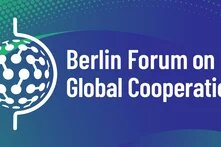As global development finance falters, the 4th International Conference on Financing for Development in Seville offers a chance to rethink the system. It’s time to move beyond donor fixes and center justice, local agency, and structural reform.

As global development budgets contract and geopolitical pressures mount, the very foundations of international development finance are under scrutiny. While the upcoming Financing for Development Conference in Seville (FfD4) aims to expand technical solutions and review institutional frameworks, a deeper rethink is long overdue: one that centers the lived realities of those most affected and reclaims development as a matter of justice – not only of financing.
This discussion came into sharp focus during this year’s Berlin Forum on Global Cooperation. Co-organized by the Heinrich Böll Foundation and the Humboldt University of Berlin, the Forum provided a space for honest dialogue about the future of global cooperation and development finance. Talking to experienced leaders and young students alike, the message was clear: the old tools no longer suffice, and the power to define what counts as development – and who gets to shape it – must shift.
A System Born of Crisis and Compromise
The current architecture of global development finance was forged in the aftermath of World War II. The United Nations and Bretton Woods Institutions were established under the haunting memory of a decade of economic turmoil and unparalleled atrocities of war, designed to secure peace, stabilize economies, and enable reconstruction. At their core was a belief in multilateral cooperation and shared responsibility for global progress.
But from the beginning, this architecture also mirrored global asymmetries. It evolved less as a neutral, rules-based system than as a negotiation of power—between North and South, public and private actors, and national interests masked as international mandates. While historical references rarely quote them, contemporaries already expressed disappointment with systematic imbalances at the birth of the UN system. These tensions have also shaped the uneven, often contradictory path of development finance for the last 80 years.
Today’s Crisis is Structural, Not Just Cyclical
Official Development Assistance (ODA), once considered the flagship of global solidarity, is under strain. With the impacts of the 2025 cuts still outstanding, ODA already experienced a decrease from 2023 to 2024 to a total of $212.1 billion in 2024. However, much of this increase was driven by in-donor refugee costs, humanitarian spending, and military assistance to Ukraine, rather than scaled support for low-income countries. Only a handful of countries met the UN’s 0.7% of GNI target, and much of the aid was delivered through earmarked voluntary contributions rather than predictable, multilateral channels. Even during periods of growth, development finance has been fraught with structural weaknesses. Donor-imposed conditionality, risk outsourcing and impact inflation, and the short-term chasing of new trends impair coordinated impact:
- Aid is often tied to political or commercial interests, shaped more by donor preferences than by recipient needs. Structural adjustment programs of the 1980s, framed as financial stabilization tools, devastated public services in many countries. The growing reliance on voluntary, earmarked contributions–especially in UN agencies – has distorted priorities and reduced transparency. In 2022, 82% of all UN funding for operational activities was earmarked, limiting flexibility and long-term planning.
- Partnerships with the private sector, while heralded as innovative, frequently shift risks onto the public and inflate impact through optimistic metrics. Inflated ODA figures often include spending with limited development relevance – such as tied aid, export credit guarantees, or the monetization of student costs and refugee hosting. In 2022, more than 20% of reported ODA did not represent a real transfer of resources to developing countries.
- The pressure to constantly deliver “new solutions” has led to a proliferation of initiatives, often undermining sustained, locally-driven development. Too often, the race toward the next big thing in development crowds out long-term systems-building and existing expertise.
In short, the development finance system is not simply underfunded – it is misaligned. Its rules, incentives, and gatekeepers too often prioritize financial flows over fairness, innovation over inclusion, and technocratic fixes over political accountability.
Rethinking from the Ground Up
A more just and resilient model must begin by re-centering development finance on the needs, expertise, and aspirations of affected people and communities. This is not just a moral imperative but backed by data. Development outcomes improve when programs reflect local knowledge and agency. Brazil’s Bolsa Familia, a conditional cash transfer initiative, has lifted over 20 million people out of poverty, reduced inequality, and improved education and health outcomes, particularly among women and children. Participatory budgeting experiments and unconditional cash transfers have shown that, when empowered with resources, people often make better decisions than distant planners or external consultants.
But for such approaches to scale, affected populations need not just voice, but resources. Three underappreciated sources of development finance offer that potential:
- Firstly, remittances to low- and middle-income countries are expected to have reached $685 billion in 2024, outmatching ODA and foreign direct investments (FDI) combined. These flows go directly to households, bypassing bureaucracies, and often outperform formal aid in reaching the poorest.
- Secondly, tackling illicit financial flows and tax avoidance could unlock vast sums. Developing countries lose over $200 billion annually through corporate tax avoidance and base erosion. Redirecting even a portion of these funds could transform national development efforts.
- Thirdly, beyond unlocking local resources, debt reform is essential. Initiatives like the Debt Relief for a Green and Inclusive Recovery (DRGR) have shown how unsustainable debt burdens not only limit fiscal space for social investments but actively force governments into austerity cycles. Transparent and equitable debt restructuring must become part of the development finance toolkit.
In all three cases, the key lies not in expanding donor-driven finance, but in strengthening people-driven systems – empowering families, communities, and governments to claim ownership over their development pathways.
A New Financing Conversation
As delegates gather in Seville for the Fourth International Conference on Financing for Development, they will debate frameworks for blended finance, climate funding, debt restructuring, and private capital mobilization. These are necessary discussions, but they must not eclipse the foundational questions: Who gets to define development? Whose priorities shape financing rules? And how can the system serve those most often excluded from its design?
The conversation must shift from what can be done for the Global South, to what is already being done by the Global South—and how global systems can stop getting in the way. Usually discussed only among civil society representatives, the current geopolitical tensions and absence of some particularly powerful representatives from the Global North might finally provide us with the space and courage to redefine the terms of the debate.
This article first appeared here: us.boell.org

